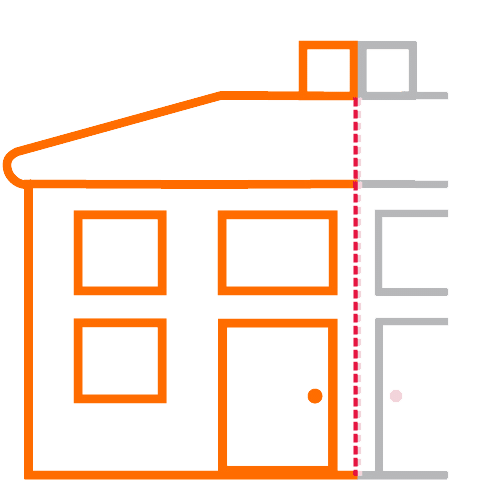In the UK for 2024, you'll need to guarantee your loft insulation meets strict building regulations, including a minimum thickness of 270mm for thermal materials and a U-value of 0.2 W/m²K. You're required to use approved insulation materials, with wool insulation being a common choice for its thermal and acoustic benefits. Proper installation techniques are vital, as inadequate insulation can lead to up to 25% heat loss and potential structural issues from condensation. Professional installation is recommended to guarantee compliance with fire safety standards and ventilation requirements. Understanding the full scope of regulations will help maximize your energy savings and investment protection.
Current Insulation Requirements and Standards
Table of Contents
ToggleWhen you're planning your loft insulation, you'll need to address both the main roof area and the floor structure.
The regulations require 100mm of wool insulation between floor joists, which serves a dual purpose: it enhances energy efficiency and provides essential sound reduction between floor levels.
You can't overlook these requirements, as proper insulation prevents up to 25% of heat loss in your home, directly impacting your energy bills and overall comfort.
It's important to recognize that failing to meet these standards isn't just about non-compliance; inadequate insulation can lead to condensation issues and potential structural problems over time.
You'll need to guarantee all installations meet current building regulations to protect your investment and maintain your home's integrity.
Heat Loss Prevention Guidelines
Understanding heat loss prevention is vital for your loft's thermal efficiency. You'll need to comply with the mandatory minimum insulation thickness of 270mm in your loft conversion to effectively minimize heat escape.
Without proper insulation, you're risking up to 25% heat loss throughout your home, which can greatly impact your energy consumption and comfort levels.
To achieve ideal thermal performance, you'll want to make sure your insulation meets the recommended U-value of 0.2 W/m²K. Installing 100mm wool insulation between floor joists serves a dual purpose: it'll enhance your home's energy efficiency while providing additional sound reduction benefits.
When you're planning your loft conversion, it's important to take these specifications into account as they're not just regulatory requirements but practical necessities for maintaining a comfortable living space.
You'll need to pay particular attention to proper installation techniques and material selection, as inadequate insulation can lead to moisture-related structural issues.
Material Types and Specifications
In today's market, you'll find several approved insulation materials for your loft conversion, each meeting the mandatory 270mm thickness requirement. Among these options, wool insulation has proven particularly effective, with 100mm installations between floor joists delivering both thermal efficiency and sound reduction benefits.
When you're selecting insulation materials, you'll need to guarantee they achieve a U-value of 0.2 W/m²K to comply with current energy standards. This measurement indicates how effectively your insulation prevents heat from escaping through your loft space.
You'll also need to verify that any materials you choose meet fire safety regulations, specifically the requirement to resist fire for a minimum of 30 minutes.
While focusing on insulation thickness and material quality is essential, you shouldn't overlook proper ventilation. You'll need to incorporate adequate airflow solutions alongside your insulation system to prevent moisture accumulation.
Without proper ventilation, you risk compromising both the structural integrity of your loft and the performance of your insulation materials, potentially leading to long-term issues that could affect your home's energy efficiency and safety compliance.
Installation Best Practices
To guarantee ideal performance of your loft insulation, proper installation techniques must be followed meticulously.
You'll need to confirm the minimum thickness of 270mm is maintained throughout the loft space, which is critical for meeting current building regulations and achieving maximum energy efficiency.
When you're installing wool insulation between floor joists, you'll want to lay the recommended 100mm thickness carefully, making sure there aren't any gaps or compression points that could compromise its effectiveness.
It's essential that you pay close attention to achieving the required U-value of 0.2 W/m²K, which you can verify through proper measurement and installation techniques.
You shouldn't overlook the importance of ventilation during the installation process, as proper airflow prevents moisture accumulation that could potentially damage your loft structure.
You'll find that following these installation standards doesn't just confirm compliance with regulations – it directly impacts your heating costs.
By maintaining consistent insulation coverage and addressing potential thermal bridges, you're creating an effective barrier against heat loss.
Remember to check for any obstructions or service installations that might affect the continuity of your insulation layer.
Cost and Energy Savings Analysis
Making the leap into loft insulation brings considerable financial benefits that extend well beyond the initial investment. When you install the required 270mm thickness of insulation in your loft conversion, you'll greatly reduce your home's heat loss, which typically accounts for up to 25% of total energy loss.
While installation costs can vary depending on your loft's size and accessibility, the long-term savings on your energy bills will typically offset the initial expenditure.
To achieve ideal energy efficiency, you'll need to meet the recommended U-value of 0.2 W/m²K, which isn't just a regulatory requirement but a practical benchmark for maximizing your investment returns.
You'll notice the benefits through reduced heating costs and improved home comfort, including enhanced sound insulation that creates a quieter living environment.
Working with certified professionals guarantees your installation meets current building standards and prevents costly corrections later.
While you might initially hesitate at the upfront costs, it's worth considering that proper loft insulation is a strategic investment that'll continue to deliver returns through reduced energy consumption and increased property value over time.





